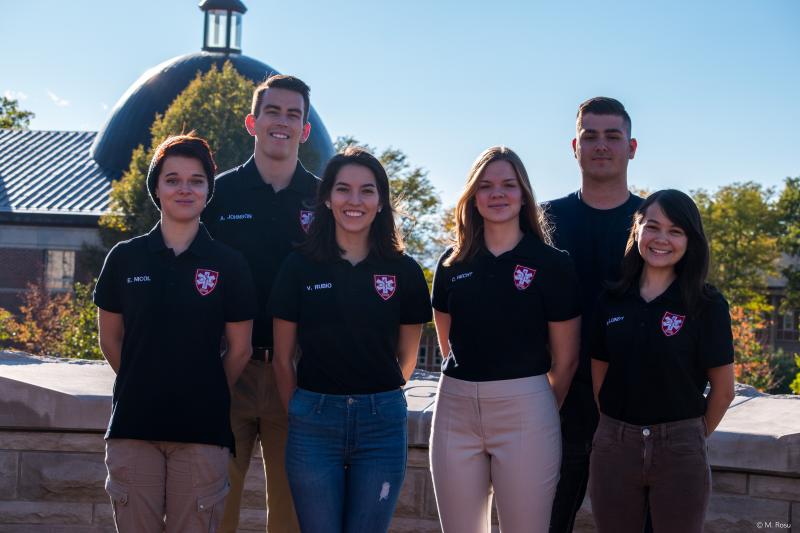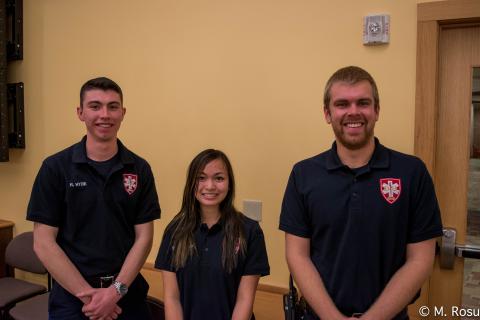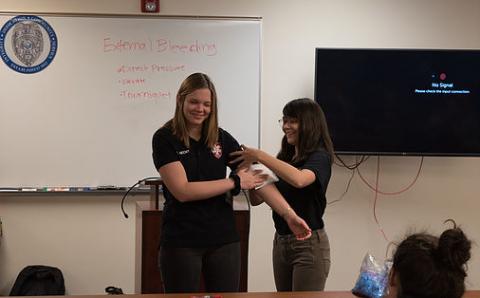DU EMS program puts student EMTs to work on campus
Club running pilot program with Campus Safety

For years Keanna Lundy, co-president of the of DU Emergency Medical Services (EMS), watched the club creep toward its foundational goal: a student-run medical unit capable of responding to campus emergencies. For years, one thing or another got in the way.
“I like to say we had the building plans,” Lundy says. “But we just got the permits.” The green light finally came from the University in October 2018. Seventeen members of the club — all certified EMTs — switched on their radios for the first time on Halloween night.
The DU EMS club was founded in spring 2016, with the help of biology teaching professor Nancy Lorenzon. Its founding members envisioned a medical response unit from day one, but issues like workers’ compensation presented ongoing challenges. But even without that key piece in place, the club grew and currently includes 120 members, 25 of whom are certified EMTs.
Now, the club’s medical response unit is up and running through a one-year pilot program with Campus Safety. To get around workers’ compensation issues, the University hired each EMT as a Campus Safety employee, complete with hourly pay, radios, a car and space in the Campus Safety office.
Members of the medical response unit are on call every Thursday, Friday and Saturday from 7 p.m.-3 a.m. When medical calls come in, teams of two sprint into action alongside a Campus Safety officer, providing first aid, CPR and AED for the DU community before handing patients off to paramedics.
So far, the crew has worked more than 300 collective hours, providing assistance on calls ranging from cardiac arrest and traumatic injury to intoxication.
The first few months of the program have primarily involved ironing out communication among Campus Safety, DU EMS and community partners like Denver Health, Denver Police and Denver Fire. During the process of integrating DU EMS into the medical chain of command, collaboration and partnership have taken shape, Lundy says.
“[Denver Health, the police and firefighters] were very accepting and very aware of the growing pains that would happen because it is a new addition to a system that is already established,” she says. “They have been very accepting of us.”
Campus Safety director Don Enloe agrees. “I think everyone has a lot of confidence in the program and wants to see it succeed,” he says. “[Denver Health in particular] has opened up training for the students and [does] it at a reduced rate. We are working with them to provide more specialized training for these EMS students.”
One of the major things DU EMS and Campus Safety are watching in the pilot is the response to student medical providers on campus.
“There is some curiosity around how students are going to feel with other students providing medical services,” Enloe explains. “We are feeling our way through that before we take our next step where they can provide more full-service pre-hospital care.”
Lundy, an EMT herself, sees her student status as an advantage. “Campus Safety and paramedics can be quite intimidating. … Having students or someone you can connect with can kind of tone down the level of authority figures,” she says.
What’s more, members of the unit already are investing in training aimed at stemming any discomfort, including classes on microagressions, HIPAA, cultural sensitivity and mental health.
Members of the medical response unit are looking forward to a future where they can have an even stronger impact on campus, says Lorenzon, who advises the club. “Right now they really don’t do any other interaction other than first aid, CPR or AED. In this next run, [hopefully] they will be able to stabilize the patient, check vitals and gather more information before handing them over for transport if need be.”
This, Lorenzon says, would free up time for both local authorities and Campus Safety, allowing them to focus their attention to other community incidents.
The program doesn’t just provide support for Campus Safety and its partners, but also to students with an interest in emergency medicine, Lundy says. “I think especially for those who have never worked as an EMT, it is good experience. When you come in you clock in, you have to get your med bag, you have to get your radios, you have to suit up and correspond with dispatch,” she says. “It’s good preliminary experience to get people comfortable with responding to a call because EMS is kind of intimidating. People put their trust in you — their health and their lives.”
That pressure is worth it, Lorenzon says. “These students have to really want to do this because they are doing this in their summers or during break or in addition to having a full load of classes — and with their own money,” she says. “They were given this opportunity to show they are responsible, they know their stuff, and they are one of the team with Campus Safety, the firemen and the police and Denver Health and paramedics. That gives them a huge sense of pride.”




